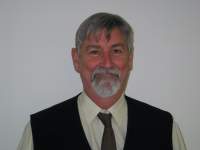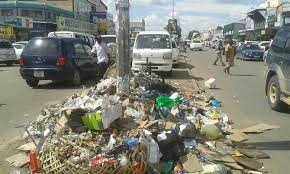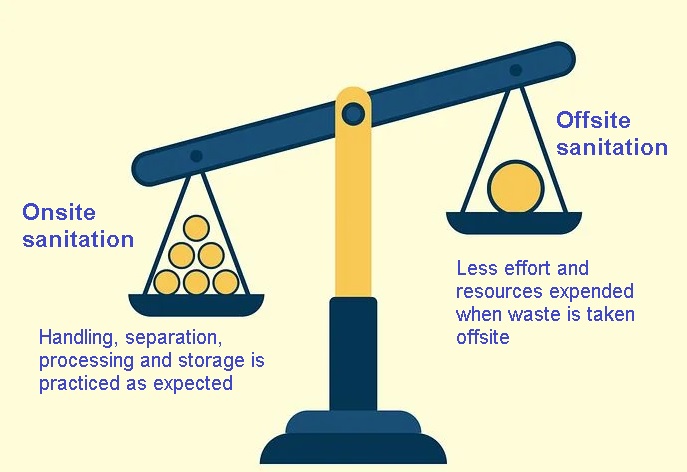- Forum
- categories
- Sanitation systems
- Solid waste management
- The SWM Problem in Lusaka, Zambia (sub-Sahara Africa) and its interaction with onsite and offsite sanitation - and how to achieve source separation for organic matter
The SWM Problem in Lusaka, Zambia (sub-Sahara Africa) and its interaction with onsite and offsite sanitation - and how to achieve source separation for organic matter
18.7k views
- Gerry
-
 Less
Less- Posts: 6
- Likes received: 5
Re: The SWM Problem in Lusaka, Zambia (sub-Sahara Africa) and its interaction with onsite and offsite sanitation - and how to achieve source separation for organic matter
My apologies for not responding sooner. Your comments were brought to my attention by the moderator. My apologies also to the moderator for not paying attention.Research in recent years has indicated that our understanding of the interaction between the application of biological products such as composts, hydrolysates, biostimulants and healthy soil and plant roots is pointing us in a direction that indicates that we can soon be farming without the use of chemical products. A paper on this subject by a countryman of yours Dr. Mahesh Venkataramaiah provides good evidence of this. I shall attach a paper which was principally written for the benefit of my colleagues in the Zero Waste and Global Alliance for Incinerator Alternative and how the argument against the burning of organic material in incinerators needs to focus on for rather than an eternal for or against.
The proposition should focus on what gives the community the best benefit. The links in this paper provide solid evidence that organic waste may well be the most valuable product we have for use in food production. We have redesigned compost systems and utilised hydrolysis to make bioferments out of protein sources. We have one project based on the latter called Feraliser where we are making hydrolysate out of feral pigs and at the same time trying to generate indigenous employment in Cape York, Queensland.
To answer your question, Jaime Lerner was the Mayor of Curitaba and though he is now deceased his work lives on. The concept he used was his need to clean up the city slums which were causing the spread of disease - he achieved the improvement in health by getting organic waste out of the slums (or waste generally - but it is only organic waste which causes the disease issues from rats and other vermin) - By paying people with transport coupons and food he had slum dwellers bring their waste out of the slums to a given point and thus reduced disease in the slums and improved living conditions. The point I am making is that we need to design systems which are focused on the bigger picture rather than short-term management of waste. Waste is only wasted because it is mixed together. If we do not mix it with other things all materials can be recycled.
A link to Jaimie Lerners work is attached: en.institutojaimelerner.org › prefeitura
This message has an attachment file.
Please log in or register to see it.
Please Log in to join the conversation.
You need to login to reply- paresh
-

- Moderator
- Budding WASH researcher, especially interested in governance, public policy, finance, politics and social justice. Architect, Urban & Regional planner by training, Ex. C-WAS, India.I am a patient person :)
Less- Posts: 383
- Karma: 7
- Likes received: 143
Re: The SWM Problem in Lusaka, Zambia (sub-Sahara Africa) and its interaction with onsite and offsite sanitation - and how to achieve source separation for organic matter
In Alleppey, a town in South Indian state of Kerala, people deposit segregated waste at community collection points as there is no alternative. But additionally, a lot of effort has been put in to educate the masses about its need and what happens to the waste after it is deposited. See this thread for some details and references: Community level composters, organic solid waste collection from householdsIf you want people to separate materials from each other you must give them:
- The right tools,
- The right motivation and
- The Correct information.
Rewarding people for segregation is also a good idea to begin with. But wondering how long can the resource constrained public utilities and governments in the Global South can manage to sustain it? And what happens when they are no longer able to mobilise funds for the purpose?
Could you please also share some material related to the experience in Curitiba you mentioned in your previous post?
Regards
paresh
Moderator, SuSanA forum
Project Manager at ADCPS
Indian Institute of Technology - Bombay, India
Please Log in to join the conversation.
You need to login to reply- Gerry
-
 Less
Less- Posts: 6
- Likes received: 5
Re: The SWM Problem in Lusaka, Zambia (sub-Sahara Africa) and its interaction with onsite and offsite sanitation: what are the possible solutions?
Please Log in to join the conversation.
You need to login to replyRe: The SWM Problem in Lusaka, Zambia (sub-Sahara Africa) and its interaction with onsite and offsite sanitation: what are the possible solutions?
In developing countries it's by no means guaranteed that residents are participating in separation at the source as it's usually called. In fact, residents might even ask for money, if you ask them to separate. That's what happened when I tried to introduce it in Uganda.
In GIZ (SuSanA is still a part of GIZ, isn't it?), there currently is a lot of talk about extended producer responsibility (EPR) in the waste sector, a concept that is taken from European counties like Germany. In fact, a deposit system for packaging, non-biodegradable in particular, would be more appropriate. That could take out most of the 'ugly' waste from the environment.
Wish you good luck with your endeavors!
M.Eng. Environmental Pollution Control
presently in Seesen, Germany
Please Log in to join the conversation.
You need to login to reply- rbanda
-
 Topic Author
Topic Author- Self-driven, motivated, organized and dilligent
Less- Posts: 4
- Likes received: 3
Re: The SWM Problem in Lusaka, Zambia (sub-Sahara Africa) and its interaction with onsite and offsite sanitation: what are the possible solutions?
Thanks for the comment!
I think that the interaction between onsite and offsite sanitation can be styled using the concept of a scale
(refer to figure below).
On one side is onsite sanitation and on the other, offsite. When
people practice good onsite waste handling, separation, processing, and
storage, the effort that will be required when the waste is taken offsite will
be minimal. Similarly, if little to no action is taken onsite, more effort will
be expended offsite. In the case of Lusaka, there isn’t much action being taken
at the onsite level. As Gerry put it, the situation can be addressed by motivating
communities to get directly involved in SWM. This can be realized by availing them
with the right tools and information.
RB.
Attachments:
Please Log in to join the conversation.
You need to login to reply- rbanda
-
 Topic Author
Topic Author- Self-driven, motivated, organized and dilligent
Less- Posts: 4
- Likes received: 3
Re: The SWM Problem in Lusaka, Zambia (sub-Sahara Africa) and its interaction with onsite and offsite sanitation: what are the possible solutions?
Great contribution!
I'm glad to learn of the 'Know your Neighbour' initiative and I believe that it will help more people to come to the realization that they're responsible for the well-being of their environment. This also resonates Gerry's point that we need to involve communities more and more.
RB.
Please Log in to join the conversation.
You need to login to reply- rbanda
-
 Topic Author
Topic Author- Self-driven, motivated, organized and dilligent
Less- Posts: 4
- Likes received: 3
Re: The SWM Problem in Lusaka, Zambia (sub-Sahara Africa) and its interaction with onsite and offsite sanitation: what are the possible solutions?
I totally agree with you in every sense. Indeed direct community involvement in SWM is crucial. I love the fact that you brought in the issue of motivation, provision of right tools and information to get everyone involved. I am quite confident that the greatest motivation for the people of my City would be 'cash for trash'. Zambia being a third-world country, cash is hard to come by. And so, offering cash incentives would turn the situation around. Information on SWM is scarce. The Local Authority is not adequately funded to run ads in the print and electronic media. But I trust that social media platforms such as facebook, twitter, etc can be utilized to reach thousands. The need for households to have the right tools cannot be overemphasized. Indeed there is more we have to do to bring about positive changes.
I appreciate your contribution.
RB
Please Log in to join the conversation.
You need to login to reply- Gerry
-
 Less
Less- Posts: 6
- Likes received: 5
Re: The SWM Problem in Lusaka, Zambia (sub-Sahara Africa) and its interaction with onsite and offsite sanitation: what are the possible solutions?
Please Log in to join the conversation.
You need to login to reply- Angela
-
 Less
Less- Posts: 3
- Karma: 1
- Likes received: 3
Re: The SWM Problem in Lusaka, Zambia (sub-Sahara Africa) and its interaction with onsite and offsite sanitation: what are the possible solutions?
Please Log in to join the conversation.
You need to login to reply- Gerry
-
 Less
Less- Posts: 6
- Likes received: 5
Re: The SWM Problem in Lusaka, Zambia (sub-Sahara Africa) and its interaction with onsite and offsite sanitation: what are the possible solutions?
Many people in governments or the waste industry will try to defend their inaction on source separation by blaming the population and saying they are lazy and will not sort materials out. Many people in the Zero Waste movement have tried applying source separation now in many, many different communities and have had very positive results. If you want people to separate materials from each other you must give them: 1. The right tools, 2. The right motivation and 3. The Correct information. They need to understand what they will get from their actions and why it is a benefit, why they will save money and why out will benefit their children. In all parts of the world the largest part of any materials stream is organic waste which can be made into a beautiful product which can replace chemical fertiliser in crop production and give you beautiful food. You can find a lot of resources at no cost on this issue on my web site: gerry gillespie.net
There is a lot more information on the Zero Waste Europe website: zerowasteeurope.eu
This includes information from over 300 communities many of which are now diverting up to 85% of their waste from landfill or incineration. If your government or waste 'professionals'; tell you this cannot be done it is because they are making a lot of money from the current system or from incineration. As I said previously companies do not make money from incineration they make money from the fees you pay to have materials burnt and the only things which will burn are things which are organic in origin. They make money because large financiers and large bankers make a lot of money from the big loans required to build and run incinerators. Once you build an incinerator you have to feed it your organic waste for 25 years, which is the usual length of the contract. You are being fooled if you think this can be sustained indefinitely. Follow the money - follow the money!!!
Please Log in to join the conversation.
You need to login to reply- Chaiwe
-

- Moderator
- Innovation enthusiast and Knowledge Management Expert in WASH and Climate Change while cross-cutting Youth and Gender Issues. CEO of CaDev_Capacity Development (An African Social Enterprise)
Less- Posts: 336
- Karma: 8
- Likes received: 116
Re: The SWM Problem in Lusaka, Zambia (sub-Sahara Africa) and its interaction with onsite and offsite sanitation: what are the possible solutions?
Nice topic of discussions this is. I especially find this section within your post ''Onsite sanitation is the first line of action in managing waste at points of generation (Figure 3).''and your title eye-catching. However, i don't find that your post really gives an account of the interactions between onsite and offsite sanitation with the solid waste management problem in Lusaka and how these can be addressed.
I would also like to really get an understanding of what you mean by this ''Onsite sanitation is the first line of action in managing waste at points of generation (Figure 3).'' can you kindly expound further?
Follow the Wikipedia definitions of Onsite sanitation and Offsite sanitation here: en.wikipedia.org/wiki/Sanitation#Onsite_sanitation
Kind Regards,Onsite sanitation (or on-site sanitation) is defined as "a sanitation system in which excreta and wastewater are collected and stored or treated on the plot where they are generated". [22] :173 The degree of treatment may be variable, from none to advanced. Examples are pit latrines (no treatment) and septic tanks ( primary treatment of wastewater). On-site sanitation systems are often connected to fecal sludge management (FSM) systems where the fecal sludge that is generated onsite is treated at an offsite location. (Offsite Sanitation or Wastewater ( sewage ) )is only generated when piped water supply is available within the buildings or close to them.
Chaiwe
Skat Foundation (With financial support by GIZ and SIRWASH up to November 2023)
Chaiwe Mushauko-Sanderse BSc. NRM, MPH
Independent consultant located in Lusaka, Zambia
Emails: This email address is being protected from spambots. You need JavaScript enabled to view it., This email address is being protected from spambots. You need JavaScript enabled to view it.
LinkedIn: www.linkedin.com/in/chaiwe-mushauko-sanderse-21709129/
Twitter: @ChaiweSanderse
Please Log in to join the conversation.
You need to login to reply- rbanda
-
 Topic Author
Topic Author- Self-driven, motivated, organized and dilligent
Less- Posts: 4
- Likes received: 3
The SWM Problem in Lusaka, Zambia (sub-Sahara Africa) and its interaction with onsite and offsite sanitation: what are the possible solutions?
Currently,the situation has worsened and reached an alarming level. The Lack of adequate funding, manpower, and inadequate equipment has tripled the Lusaka City Council such that they are unable to offer their services acceptably. As collection services are non-existent in most places, especially the slums, people have continued to dump waste indiscriminately. The Lusaka Central Business District (CBD) is a sorry sight to behold. Heaps of garbage can be seen on streets such as the Freedomway.
So, the question we can now pose is,
“what are the possible solutions to the garbage situation in Lusaka?”
Well, to start with, the Lusaka City Council needs to be adequately funded so that they can hire more workers and acquire adequate equipment. Besides other possible solutions, there is one critical element that we’ve been neglecting for a long time - onsite sanitation.
Onsite sanitation is the first line of action in managing waste at points of generation (Figure 3). Full participation of the public in taking care of their immediate environment is the first step to winning the war against solid waste. Every citizen must be reminded and made aware of their role in waste management. How? By carrying community sensitization, organizing awareness workshops and seminars, and incentive-based sanitation programs. In addition, we need to champion the promotion of environmentally friendly practices such as recycling.
Remember, "charity begins at home!"
Attachments:
-
 Figure1.jpg
(Filesize: 64KB)
Figure1.jpg
(Filesize: 64KB)
-
 Figure2a.jpg
(Filesize: 23KB)
Figure2a.jpg
(Filesize: 23KB)
Please Log in to join the conversation.
You need to login to reply- Forum
- categories
- Sanitation systems
- Solid waste management
- The SWM Problem in Lusaka, Zambia (sub-Sahara Africa) and its interaction with onsite and offsite sanitation - and how to achieve source separation for organic matter











